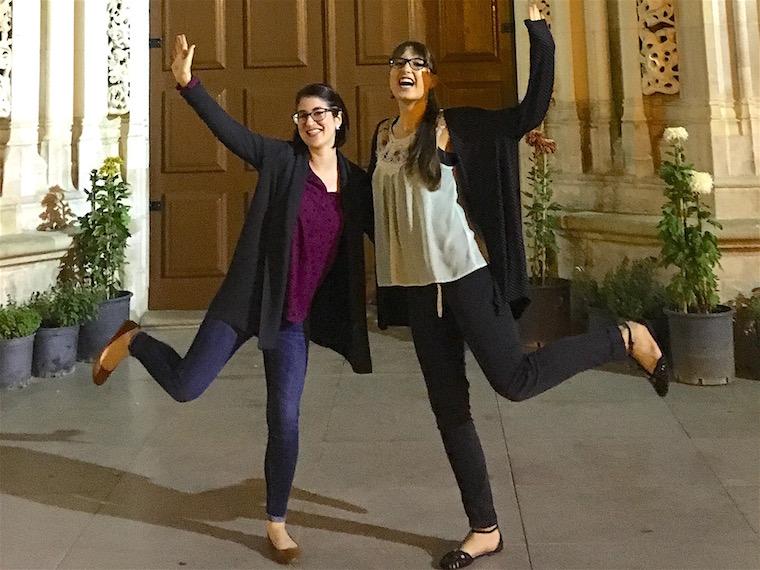Four Days in Portugal
December 9, 2016
Christine Jay ’17

Baroque flutists Natalie Talbot '17 (left) and Christine Jay '17 devoted a week of their fall semester to attending an international musical instrument conference in Portugal.
Photo credit: Courtesy of Christine Jay
Flying to a foreign country on a school night is as exciting as it is disorienting. In the predawn hours of a late October morning, I set off from Cleveland for a short week of discovery at an international music conference in Portugal, joined by my friend and fellow baroque flutist Natalie Talbot ’17.
Our trip was supported by the Oberlin Conservatory student travel fund and made possible by our teacher, Michael Lynn. A longtime professor of recorder and Baroque flute at Oberlin, Lynn has enjoyed a diverse career not only as an educator, but as a flute collector, acclaimed soloist, columnist for several flute magazines, and as a founding board member of Cleveland’s acclaimed Baroque orchestra, Apollo’s Fire. Internationally recognized for his expertise, Lynn hosted a conference on 19th-century French flutes at Oberlin in fall 2015.
Lynn’s work caught the attention of Patricia Bastos, director of Portugal’s National Association for Musical Instruments (known by its Portuguese acronym ANIMUSIC). She invited him to curate flute presentations for its 2016 Organological Congress, where myriad instruments—from the historic carillons of Mafra to the keyed trumpet—were presented, demonstrated, and performed at picturesque castles and libraries. Because the conference’s focus for 2016 was on flutes, Lynn encouraged us to join in the experience too.
After an overnight flight to Lisbon and a two-hour bus ride, we settled in the lovely and inviting host town of Tomar. There, we connected with our professor and more than a dozen other international performers and musicologists at the town library—the conference’s home base—and left on a bus to the famous Castelo de Tomar, an original 12th-century Templar stronghold. Several participants presented papers at the castle, followed by performances by Lynn and others. Their playing in these exceptional medieval acoustical spaces proved to be one of the trip’s most magical moments.
The next day brought more travel, this time to a convent-turned-museum overlooking the town of Abrantes. There, a series of presentations included Lynn and scholars from Canada, Romania, and Portugal. The day continued with an organ concert a short walk from the convent, a stop at a Portuguese dessert festival in the nearby town, and dinner at a medieval restaurant back in Tomar. Both intellectually and gastronomically stimulating—with multiple coffee and cookie breaks—this was the best day of the trip overall.
Day 3 was filled with lectures and papers presented at the Tomar town library. Here, the conference’s “Flute Focus” theme came to its peak with a comparison by Belgian flutist and maker Jan de Winne of original flutes to modern copies, and the inherent acoustical challenges historical instrument makers face living in the modern age. In order to help attendees understand the sweetness of antique flutes, one flute by the 18th-century maker Carlo Palanca—now owned by Winne—was available to play. (Lynn estimates about 28 original Palanca flutes exist in private and museum collections.)
Later in the day, Natalie and I played a French trio—Boismortier’s Trio Sonata No. 1, Op. 7—with a fellow flute student from Portugal. Although nerve-wracking to be among so many fine international traverso players, the performance went very well, and Natalie and I were relieved.
Our final day was busy with three destinations, first to nearby Constancia, where we visited the Igreja Matriz and its historical organ, expertly played and presented by local organist Ana Elias. We continued with a trip to beautiful Margarida Park and its tropical butterfly garden, where nature intermingled with more presentations of scholarly papers. Later, Elias performed on a portable carillon, resulting in what was perhaps the most unusual but enjoyable concert I have ever attended.
Our bus stopped at a few picturesque castles before delivering us back in Tomar for a final goodbye soiree at the library. Natalie and I reluctantly parted with the friends we had made on our journey—especially Bastos, ANIMUSIC’s director and a tireless advocate for Portuguese music and international collaboration. The next morning, we boarded an early train to Lisbon and began our 16 hours of travel back to Oberlin and the second half of fall semester.
Though it lasted little more than four days, it was a life-changing trip for me. The ability to meet and perform with international professionals and students away from the “Oberlin bubble” was exactly what all conservatory students should experience: a chance to take a risk, travel, and experience the international language of music.
Christine Jay is a fifth-year, double-degree student pursuing vocal performance, baroque flute, and Italian translation. Natalie Talbot will complete a master’s degree in historical performance at Oberlin in 2017.
You may also like…
Josh Nolan Named Vice President, General Counsel, and Secretary at Oberlin
Distinguished attorney brings extensive experience in higher education law.
Learning by Teaching: Oberlin Students Share Global Music with Young Learners
College and Conservatory students in PACE 103 prepare local children for an immersive community concert at Oberlin.
Nuiko Wadden ’02 Joins Oberlin Conservatory Faculty as Assistant Professor of Harp
The versatile musician brings extensive opera, orchestral, and contemporary music experience to her role


